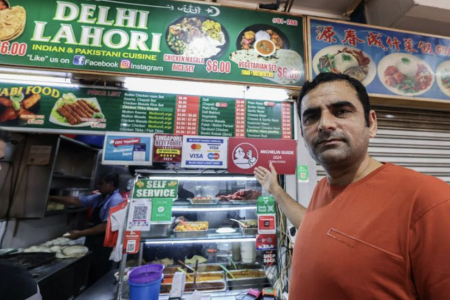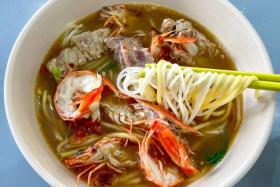A little ‘Bib’ in Little India
Arriving at Tekka Food Centre during peak lunch hour, I faced a battle with a dozen or so diners for an open table.
Biryani, appam, thosai and even Sri Lankan fare are on offer amid rows of stalls in the belly of Little India. But on a random Tuesday last week, it was a charcoal-baked naan shop with green signage that caught most people’s attention.
Known for its fluffy, crispy naans, butter chicken and grilled-to-order seekh kebab, Delhi Lahori, an Indian-Pakistani food stall, has just been added to the list of 81 Singapore eateries on the 2024 Bib Gourmand List.
Released in June by the Michelin Guide Singapore, the Bib Gourmand distinction, symbolised by the “Bibendum” or “Michelin Man”, recognises both restaurants and street food eateries that Michelin inspectors deem to offer the best value for money.
In total, there are 283 locations listed on the eighth edition of the guide: 51 starred restaurants, 81 Bib Gourmand eateries and 151 Michelin Selected venues.
There are currently four Indian eateries on the Bib Gourmand list: Anglo Indian, Muthu’s Curry, Lagnaa and Delhi Lahori – the only hawker outlet among the quartet.
Eventually, after 20 or so minutes of waiting, a table opens up in front of the stall, where shop owner Naseer Ahmed Khan stands in front of a glass showcase of aloo gobi, bindi masala and tandoori chicken thighs.
Options are aplenty, but it is Mr Naseer’s butter chicken and seekh kebab that are most revered – according to reviews online at least – and so I order both, along with a garlic naan.
I’m told the waiting time is about 10 minutes, and Mr Naseer explains that the stall makes the naan and kebabs fresh upon order. “Usually it takes 7-10 minutes. For the fish tikka and seekh kebab, even if we’re very busy, we always prepare it fresh,” he says.
Sitting down for a conversation, the 47-year-old tells me he was surprised to hear his shop was included on the Michelin list.
“It’s wonderful to know that an ordinary hawker stall can be included on such a list,” he says, adding that since the award, business has spiked 10-15 per cent.
“I used to work in hotels, as a sous chef, with Michelin-starred chefs so I knew about the stars and all that. But I’ve never heard of Indian hawker stalls getting such recognition.
“Even until now, people have been coming and congratulating us. It’s really very nice.”
A permanent resident who hails from Lahore in Pakistan, Mr Naseer has worked at various Indian restaurants in Singapore since 2000. He opened Delhi Lahori in 2018 at International Business Park in Jurong. The stall relocated to Tekka, where the monthly rent is $3,700, in 2020.
The newfound fame has attracted various clientele to the Tekka outlet, including other Michelin-starred chefs.
“The chef from (now-defunct) Song of India, Manjunath Mural, has come here many times. He likes the food,” says Mr Naseer. Incidentally, Mr Manjunath once led The Song of India to a Michelin Star for three consecutive years.
When the food arrived, the soft, pillowy naan was too hot to tear – it had just surfaced from the depths of the conspicuous clay oven located in the modest-sized stall. Think of the aroma of freshly baked bread infused with garlic; this was surely an item you needed to eat on the spot.
The butter chicken was not too heavy – almost like a deliciously spiced tomato soup with chunks of barbequed chicken that gave the dish a smoky undertone.
The star of the meal, though, were the two pieces of lamb seekh kebab. So tender that you could barely pick it up with a fork, the kebabs were served without any mint chutney – because it simply wasn’t needed.
“We don’t want to sacrifice our authenticity,” says Mr Naseer. “That’s why we cook using charcoal and a clay oven. Otherwise, the true flavour of the seekh kebab won’t be there.”
I tell Mr Naseer I’m curious about the name of his stall. “Why Delhi and Lahori? Those two cities aren’t really on the best of terms, you know,” I say in jest.
“Singapore is a multiracial country, so if we put only a Pakistani or Indian name, it’s not catering to everyone,” says Mr Naseer, who lives here with his wife and five children.
“So the name is to attract both groups of people. Food-wise, the cuisines are almost the same.”
Get The New Paper on your phone with the free TNP app. Download from the Apple App Store or Google Play Store now


